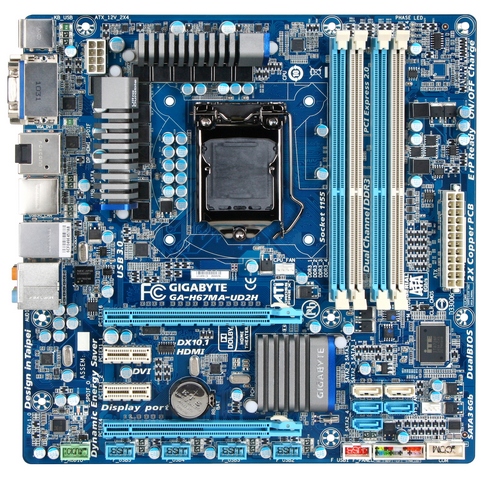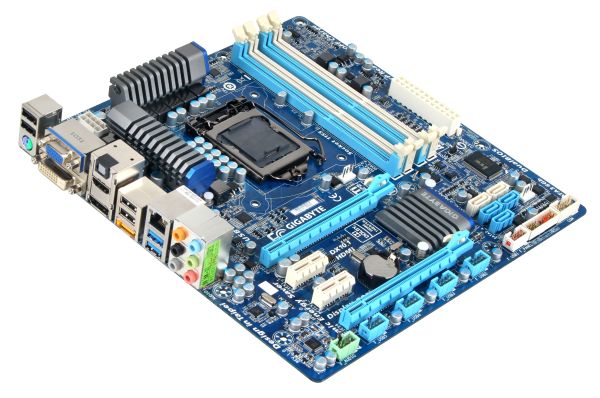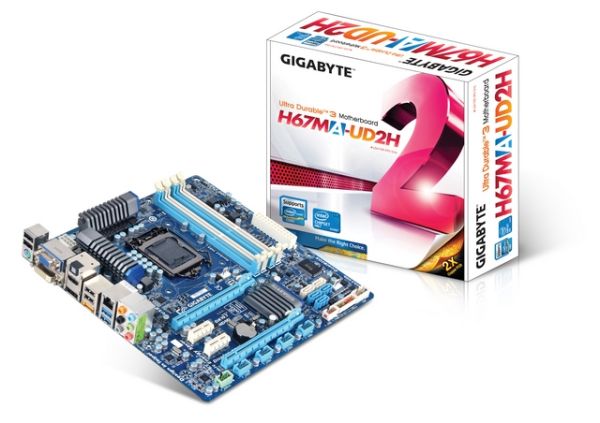H67 – A Triumvirate of Tantalizing Technology
by Ian Cutress on March 27, 2011 6:25 PM EST- Posted in
- Motherboards
- Sandy Bridge
- H67
Overview
The Gigabyte H67MA-UD2H is technically one of sixteen (!) H67 products that Gigabyte have listed on their website. Due to the issue regarding Intel and the chipset recall, Gigabyte have re-released all their boards with the new B3 stepping, and modified their name to match. So the H67MA-UD2H we are testing here is the equivalent of the H67MA-UD2H-B3, but in reality they are the same motherboard, and perform the same, apart from the minor chipset error changed. We expect the UD2H-B3 version to retail at the same as well - $125.
The UD2H has a similar issue to the other two boards tested here today, in that while it states in the BIOS that under single thread loads, the processor should invoke its turbo mode from 33x multiplier base to 37x. In reality it stays for most (98%+) of the time at the 36x multiplier, and very rarely hits 37x, even for short periods of time. I was initially told by ASRock that this is an Intel specification, and it does seem that way. As a result, I can only conclude that by buying a H67 board, consumers are losing that last turbo boosted multiplier under single thread environments. Tsk.
After testing the motherboard, it was a mixed bag of joy and disappointment. On the one hand, the UD2H was the only board out of the three H67 we test here that allowed some form of CPU Overclocking. At first glance in the BIOS, I thought it was better than expected given some of the options (it looked like I could set the CPU to the max turbo multiplier for 100% of the time), but delving deeper I discovered this was not the issue. The 3D performance wasn’t stellar, and the motherboard only has two fan headers on board, meaning my Corsair H50 could only have both fans rotating with an additional 3-pin to molex connector. The design is also a little different…
Visual Inspection
Gigabyte has taken a different tack to ASRock and ECS is our little H67 combined product review – the layout of the board is different (PCIe x4 instead of a PCI) for a start. The SATA ports are all further into the board, and the RAM slots are further away from the 24-pin power connector, leaving a relatively large gap on the board.

With the SATA ports further into the center of the board, and also angled 180° compared to previous manifestations I have encountered, it makes it a little trickier to fit cables in when the board is in a case and a dual slot GPU is present. The PCIe configuration is x16, x1, x1, x4 (electrical), and thus does away with the PCI slots seen on the other boards. Technically these boards do not support Crossfire, and I attempted to fit two GPUs into the board for testing. However, my 5850s are long, dual slot GPUs, and obscure the SATA ports which prevent me testing. Perhaps two short, single slot cards would fit, but unfortunately I have none available to test with.
Another point of interest is the board color – Gigabyte are known for their black and blue boards. But as seen in my review of the P67A-UD4, Gigabyte was veering towards a purely black scheme, as it apparently helps overclocking, according to Gigabyte. As H67 is not a CPU-OC chipset, Gigabyte may have forgone the 10¢ of color and passed the savings on to the consumer. Possibly.
Along the bottom are a plethora of USB headers, but no fan headers. In fact, this board is somewhat lacking fan headers – there is one for the CPU, which is oddly south of the CPU socket, and another next to the SATA ports. Trying to fit a Corsair H50 required some deft placing of the cooler or a fan extension lead, and the second fan required a 3-pin to molex connector.
While no legacy floppy drive connector on board, the PS/2 port in here, along with four USB 2.0 ports, two USB 3.0 ports, the four standard H67 video outputs (D-Sub, DVI-D, HDMI and DisplayPort), a SPDIF_OUT port, an eSATA 3Gb/s port, and the standard Realtek audio inputs and outputs. While there is not a Clear CMOS button, the onboard systems are quite handy at moving into a bootable mode when unbootable settings are chosen.













56 Comments
View All Comments
bigboxes - Monday, March 28, 2011 - link
That's why I always have a spare video card for just such an emergency. Since my motherboards tend to be on the higher end they don't have video out anyways. I wouldn't want the mfg to take away other ports just to include video out. It makes sense on HTPC applications as well as low end or micro-ATX boxes where utility is the priority. I just buy a cheap card that is $30 after rebate and leave it in the box until I need it for troubleshooting or in case of emergency.rustycurse - Monday, March 28, 2011 - link
on page 1:"The same question ultimately applies to the Sandy Bridge chipsets – why only allow CPU overclocking on P67 (and Z68 in the future)? "
I was always thought that term 'Sandy Bridge' is applied to CPU technology and 'Cougar point' to the chipset or am I wrong?
...but about shown mobos ... neither of them suit my tasks. I won't buy it
crispbp04 - Monday, March 28, 2011 - link
"The ECS H67H2-M is a few serious check points against it as a board to use."is or has?
WasabiVengeance - Monday, March 28, 2011 - link
Quick question: How many of those vid outputs can the board actually use simultaneously? Previously intel chipsets were limited to 2.Shadowmaster625 - Monday, March 28, 2011 - link
"However, I remember the time when I was a scrimping student. I wanted high gaming performance at the lowest cost – if Sandy Bridge was out then, and I was specifically after the Sandy Bridge platform over anything AMD, then a H67 with an i3-2100 and the biggest graphics card I could afford would be a viable option."That would be a huge waste of money. Why buy an i3-2100 if you're just going to plug in a gpu anyway? And why buy an H67 when it clearly costs $50 beyond what it should, especially since it has no northbridge.
An ASRock M3A770DE motherboard AND an Athlon X3 cpu together costs the same as one of these H67 scams. Not to mention the $125 for the intel cpu. No way. If I needed more cpu performance I would get the Phenom II X4 965 Black Edition and still have an extra $50 that could go into a better gpu.
DaveSimmons - Monday, March 28, 2011 - link
For budget gaming, H61 seems the better choice by far, with motherboards in the $60-65 range, At that price the price advantage of AMD budget CPUs go away (at stock speed anyway) and the intel HSF is quieter than stock AMD HSF from what I've read.SilentPCReview compared Intel Core i3-2100 vs. AMD Phenom II X2 565 and the intel won on both performance and power use. Spend a bit more for an i5 and you'll have a solid midrange gaming system.at a budget price.
ritchan - Tuesday, March 29, 2011 - link
"With H67 and its no overclocking rule, the market that wants a cheaper board can get that cheaper board."Yet these reviewed boards are still on average more expensive than an AMD board in an equivalent market segment. Which support overclocking and core unlocking. Also, bargain bin motherboards haven't been known for their overclocking prowess, i.e. the power window argument doesn't hold. If you're buying cheap, you get that power window anyway.
Also notice how the cheaper AMD boards like the 870-UD3R or MSI's boards come with absolutely no heatsinks on the VRMs. Bye bye, power window argument.
Stop trying to justify negative market segmentation. The H67/P67 split is a step back from where things were before, and it only gives Intel a good excuse to charge extra for overclocking enabled chipsets in the future. Wait, they're already doing that... and you're sugarcoating it for them.
glad2meetu - Tuesday, March 29, 2011 - link
I think Intel has done a very poor job with the Sandy Bridge release. Intel appears like it is lost in the woods these days and needs a new CEO.I think I would choose a ASUS or a Gigabyte motherboard if I had to pick one for Sandy Bridge. I am surprised how poor the Intel chipsets are. Intel inside no longer means anything special.
strikeback03 - Tuesday, March 29, 2011 - link
The CPUs are special. The rest of the platform, not so much. If Z68 had been included at launch, and all 6 series chipsets had included USB3 and all SATA ports 6Gbps (not just 2) then I would have a different opinion.strikeback03 - Tuesday, March 29, 2011 - link
Is a cooling fan for RAM really necessary on a platform that allows essentially no overclocking and has relatively fixed memory settings?Also, Intel advertising these CPUs as having a certain multiplier in single-threaded mode then not letting the motherboards use that multiplier is a load of bull.